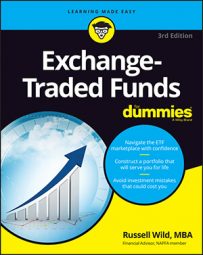Standard deviation shows the degree to which a stock/bond/mutual fund/ETF’s actual returns vary from its average returns over a certain time period.
For example, imagine two hypothetical ETFs and their returns over the last six years. Both portfolios start with $1,000 and end with $1,101. But there is a great difference in how much they bounce. ETF A’s yearly returns range from –3 percent to 5 percent while ETF B’s range from –15 percent to 15 percent. The standard deviation of the six years for ETF A is 3.09. For ETF B, the standard deviation is 10.38.
| Balance, Beginning of Year | Return (% Increase or Decrease) | Balance, End of Year |
|---|---|---|
| ETF A | ||
| 1,000 | 5 | 1,050 |
| 1,050 | –2 | 1,029 |
| 1,029 | 4 | 1,070 |
| 1,070 | –3 | 1,038 |
| 1,038 | 2 | 1,059 |
| 1,059 | 4 | 1,101 |
| ETF B | ||
| 1,000 | 10 | 1,100 |
| 1,100 | 6 | 1,166 |
| 1,166 | –15 | 991 |
| 991 | -8 | 912 |
| 912 | 15 | 1,048 |
| 1,048 | 5 | 1,101 |
Predict the range of return for ETFs
What does the standard deviation number tell us? Let’s take ETF A as an example. The standard deviation of 3.09 tells you that in about two-thirds of the months to come, you should expect the return of ETF A to fall within 3.09 percentage points of the mean return, which was 1.66.
In other words, about 68 percent of the time returns should fall somewhere between 4.75 percent (1.66 + 3.09) and –1.43 percent (1.66 – 3.09). As for the other one-third of the time, anything can happen.
It also tells you that in about 95 percent of the months to come, the returns should fall within two standard deviations of the mean. In other words, 95 percent of the time you should see a return of between 7.84 percent [1.66 + (3.09 × 2)] and –4.52 percent [1.66 – (3.09 × 2)]. The other 5 percent of the time is anybody’s guess.
Compare the risk of two ETFs
The ultimate purpose of standard deviation is that it gives you a way to judge the relative risks of two ETFs. If one ETF has a 3-year standard deviation of 12, you know that it is roughly twice as volatile as another ETF with a standard deviation of 6 and half as risky as an ETF with a standard deviation of 24.
A real-world example: The standard deviation for most short-term bond funds falls somewhere around 0.7. The standard deviation for most precious-metals funds is somewhere around 26.0.

